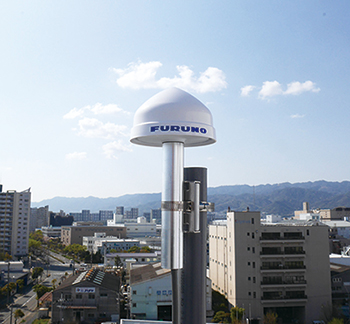Technology
Strengthening Critical Global Infrastructure: Ushering in an Era of Dual Band GNSS Signal Reception for Time Synchronization
* This is the English translation of our article in Japanese that was published in the December 2023 issue of Telecommunication Magazine.
Time synchronization is an important factor in mobile telecommunications and other critical infrastructure. However, jamming and other such issues can prevent the accurate reception of signals, leading to a wide range of problems. By offering the world's best-in-class time stability and high robustness together in one package, the GT-100 dual band GNSS receiver provides a means of preventing such unpredictable problems.
GNSS Time Synchronization for Supporting Critical Infrastructure
Critical infrastructure, including telecommunications, financial services, broadcasting, electricity and more, is available 24 hours a day, all year round – these are things we have come to expect as the norm. Therefore, losing the ability to use one's mobile phone or carry out financial transactions can have major adverse impacts - big enough to cause security concerns.
Multiple layers of systems and measures are utilized in order to maintain regular, stable operations in such infrastructure; one example of this is time synchronization based on Coordinated Universal Time (UTC) using satellites in a Global Navigation Satellite System (GNSS). The degree of time synchronization accuracy required by this system is far beyond the accuracy we require for scheduling day-to-day tasks using clocks. In 5G mobile communication networks, for example, base stations must synchronize with accuracy down to the nanosecond level in order to prevent radio-wave interference and successfully provide voice calls and data transmission services.
The key requirements for this time synchronization system are "accuracy" and "stability”: standard IT systems and electronic devices require accuracy down to anywhere from the millisecond to the microsecond level, while 5G networks demand nanosecond-level performance. The International Telecommunication Union Telecommunication Standardization Sector (ITU-T) G.8272 PRTC-A international standard prescribes a time error tolerance 100 nanoseconds or less, whereas G.8272 PRTC-B requires 40 nanoseconds or less.
And with 5G networks and other such important infrastructural systems that require time synchronization, there exists an additional need: sufficient robustness to avoid interruptions in synchronization operations.
GNSS receivers are often used to synchronize with UTC, which serves as the time synchronization basis. But when a receiver is located in an urban area, signals transmitted from GNSS satellites may be interrupted or degraded due to surrounding buildings, and also affected by time of day. Furthermore, jamming can occur at times, which blocks signal reception. The network requires a high enough level of robustness to prevent such unpredictable phenomena from affecting operations.
Robustness via Dual Band Signal Reception to Ensure Continued Services in the Event of Jamming
To counter the abovementioned challenges, the market often turns to dual band GNSS receivers.
In the past, single band receivers, which use only L1 frequency band (1575.42 MHz) to receive signals, were most common. Dual band receivers, however, can receive signals on L5 band (1176.45 MHz) in addition to L1 band. The newly developed dual band receiver module GT-100 was released by FURUNO ELECTRIC CO., LTD., a company with many years of experience supplying the market with GNSS modules for time synchronization operations. As Chief Engineer Kunihiko Hashimoto of the Technological Research Section (Research & Development Department, System Products Division) explains, "Even if a problem occurs with L1 band signal reception, L5 band reception capability enables continued provision of infrastructure services." Important critical infrastructure demands high robustness, and by offering dual band (L1/L5) signal reception, the GT-100 provides the solution that society needs. Adds Mr. Hashimoto, "By disseminating dual band reception technology, we hope to strengthen critical infrastructure around the world."

The GT-100 is a new generation of GNSS receiver module for time synchronization that supports dual band L1/L5 reception and is compatible with all constellations.
Signal jamming and spoofing attacks are not at all uncommon, nor is unexpected noise generated by wireless system signals, all of which interfere with GNSS signal reception. In such situations, engineers must visit facilities in person to investigate and uncover the problem. When a dual band receiver is used, however, L5 band signal reception enables uninterrupted services even when L1 band is temporarily unavailable (and the reverse is also true). Mr. Hashimoto elaborates: "When one considers the costs of sending engineers to the site of a problem to investigate and solve a signal reception problem, it's clear that investing in a dual band receiver really pays off."
A GPS firewall used to detect and block interfering signals is one means of addressing jamming and spoofing interference, but this can cost thousands of Dollars to implement. And with the increasing need for and spread of portable base stations, wireless disaster warning systems, police radios, receivers for financial and electric power services, and other such applications, those costs will only grow further. Dual band compatibility bolsters the robustness of the GNSS receiver itself, serving as an effective solution that balances both costs and operational stability.
Moreover, dual band receivers can compensate for signal delays originating in the ionosphere to provide improved time and positioning accuracy.

The transition of signal strength when strong jamming is input to the L1 band.
With Furuno’s GT-100, full performance time synchronization operations continue even if one of the signal bands is interrupted.
Preserving Original-model Strengths While Implementing New-model Improvements to Meet User Needs
The dual band GT-100 module was released at a time when the market demanded such a product, and it provides outstanding time synchronization accuracy and stability - which are proven FURUNO ELECTRIC strengths - along with assured robustness.
Everything from the chip through to the software for the GT series has always been developed completely in-house at FURUNO ELECTRIC. Furthermore, the previous single band model achieved some of the world's best-in-class time stability with less than 4.5 nanosecond error, and the newer GT-100 was developed based on that existing model. Even if L1 cannot be received, GT-100 still fulfills the specifications just by receiving L5. Other types of dual band GNSS receivers do exist, of course. However, as Mr. Hashimoto points out, only FURUNO ELECTRIC can offer the advantages of excellent accuracy, stability and robustness together in one product package, which are requirements in the market for critical infrastructure where stoppages cannot be permitted. The GT-100 is compatible with G.8272 PRTC-A and G.8272 PRTC-B, and outputs highly reliable time information based on UTC synchronization. In addition to pulse output, it also provides direct clock outputs for a variety of applications - 10 MHz, 2.048 MHz, 19.2 MHz and 30.72 MHz.
In addition to this GNSS receiver module, FURUNO ELECTRIC has also released the AU-500 antenna which supports dual band reception in both L1 and L5 bands, making for a combined setup that fully harnesses the power of dual band reception.
But these aren't the only advantages offered by the GT-100—it comes with other features that bolster time-synchronization operational robustness in order to strengthen critical infrastructure on a global scale.
One such feature is holdover, which enables the receiver to maintain chronological accuracy during maintenance if the antenna malfunctions or breaks down and becomes temporarily unable to receive signals. This makes it possible to maintain device performance during short-term signal interruptions in GNSS satellite transmissions. This feature was included in response to demand from users in urban areas and similar locations who experience communication disruptions during their operations. The GT-100 is compatible with this holdover.

The AU-500 antenna is compatible with dual band (L1/L5) reception.
The degradation of accuracy in urban areas is minimal. GT-100 also supports the reception of India's NavIC.
The GT-100 also inherits Dynamic Satellite Selection functionality from the previous model, which is a technology enabling selection of the best quality signals in urban areas where buildings interfere with transmission or places where frequent signal wave reflection causes timing and position issues. It is an algorithm-based multipath mitigation technology developed by the Nippon Telegraph and Telephone Corporation (NTT), and a key element in mitigating accuracy degradation in urban areas with poor transmission environments.
FURUNO ELECTRIC has installed a test bed and is currently using it for verification tests of this technology in Osaka's Nakanoshima district, which is a urban area where GNSS receivers tend to perform poorly. Says Mr. Hashimoto, "Compared with single frequency L1 band receivers, the dual frequency L1 and L5 band receiver realizes greatly reduced signal error. Our verification tests have shown that the addition of Dynamic Satellite Selection technology to this makes for nearly zero error."
Full support of all GNSS
Another major advantage of the GT-100 is its full-constellation support, making it compatible with systems including the United States' GPS, Russia's GLONASS, Europe's Galileo, China's BeiDou, Japan's QZSS and India's NavIC, as well as various regional satellite-based augmentation systems (SBAS). This enables the release and use of the GT-100 in a wide range of countries and regions around the world.
FURUNO ELECTRIC's previous GT-series model already achieved stability to within 4.5 nanoseconds, which was one of the world's top levels, and came equipped with technologies to reduce performance declines in urban areas. Now, the new GT-100 adds increased robustness through dual band reception capability. It achieves the carrier-grade quality required by mobile base stations, and provides reliable support for uninterrupted operations regardless of unpredictable problems and unreliable transmission environments. Moving forward, the GT-100 is sure to see many useful applications in mobile networks as well as economic and social infrastructure systems everywhere.
Related Products
GPS/GNSS Modules
GPS/GNSS Antennas
List of Technologies
-
What is GPS?


-
Multi-GNSS (Multi-frequency GNSS)


-
Supporting Android™

-
Dead Reckoning(DR)

-
Advanced Multipath Mitigation


-
Active Anti-Jamming


-
Anti-jamming performance of FURUNO Multi-GNSS timing receivers

-
Positioning at 10Hz update rate

-
Self-ephemeris™

-
AGNSS (Assisted GNSS)


-
High sensitivity GPS


-
FURUNO GPS/Multi-GNSS Disciplined Oscillator (GPSDO/GNSSDO)

-
GPS/GNSS GlossaryNEW

-
Strengthening Critical Global Infrastructure: Ushering in an Era of Dual Band GNSS Signal Reception for Time SynchronizationNEW

-
Introduction to GV series products(Flash film contents)

-
What is Frequency generator?(Flash film contents)





